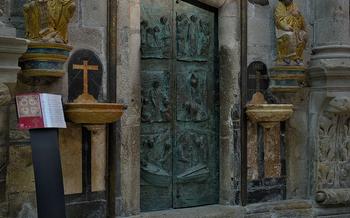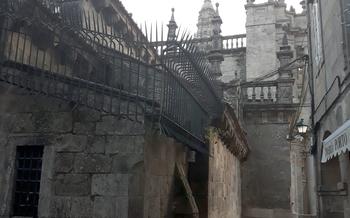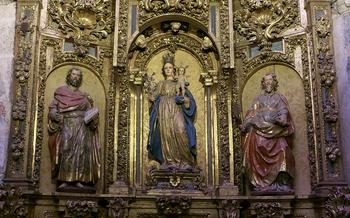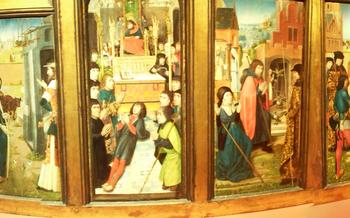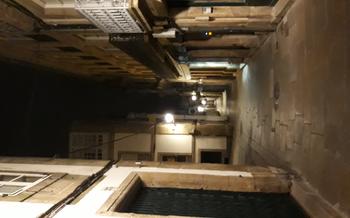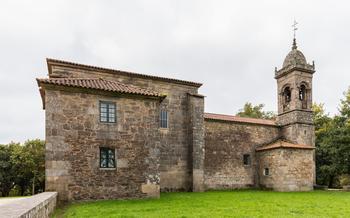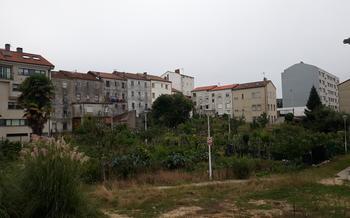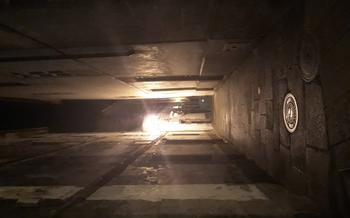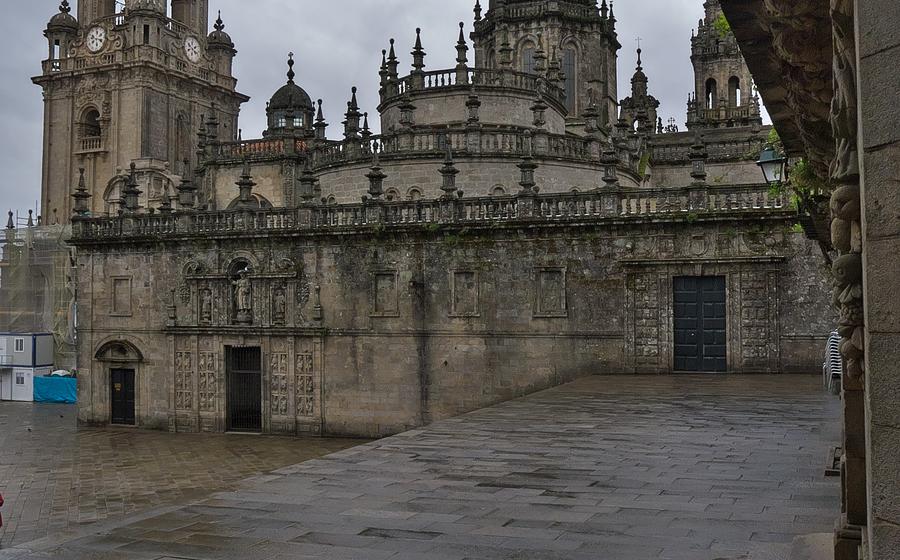
Torre de la Berenguela Bell tower of the Cathedral
- The Bell Tower of the Cathedral: A Symbol of Faith
- A Journey Through Time: Exploring the History of the Tower
- Architectural Marvel: Unveiling the Design
- A Panoramic Spectacle: Views from the Tower
- The Mystery of the Torre de la Berenguela
- The Bell Tower's Role in the Camino de Santiago
- Tips for Visiting the Torre de la Berenguela
- The Tower's Connection to the Cathedral
- The Legend of the Bell Ringer
- Exploring the Surrounding Area
- The Tower's Role in Local Culture and Identity
- Restoration and Conservation Efforts
- The Tower as a Symbol of Resilience
- Insider Tip: Discovering Hidden Gems
The Bell Tower of the Cathedral: A Symbol of Faith
The bell tower of the Cathedral of Santiago de Compostela, also known as the Torre del Reloj, stands as an iconic symbol of the city and a testament to its deep religious significance. Constructed in the 18th century, the tower showcases a harmonious blend of Baroque and Neoclassical architectural styles. Its elegant façade, adorned with intricate carvings and sculptures, reflects the grandeur of the Cathedral itself.
The tower serves as a constant reminder of the city's devotion to Christianity. Its bells, which chime melodiously throughout the day, call the faithful to prayer and mark the passage of time. The tower's presence is particularly poignant during religious festivals and processions, when its bells toll solemnly, adding to the sacred atmosphere of the city.
From the top of the bell tower, visitors are rewarded with breathtaking views of the city, the surrounding countryside, and the distant mountains. The panoramic vistas offer a unique perspective on the city's layout, revealing the intricate tapestry of streets, plazas, and landmarks that make Santiago de Compostela a captivating destination for pilgrims and tourists alike.
The bell tower's role in the Camino de Santiago is particularly significant. For centuries, pilgrims have made their way to Santiago de Compostela, following the ancient routes that converge in the city. The sight of the bell tower, rising above the cityscape, serves as a beacon of hope and a symbol of the completion of their arduous journey. The ringing of the bells signals their arrival in the holy city, a moment of profound spiritual significance for many pilgrims.
A Journey Through Time: Exploring the History of the Tower
The Torre de la Berenguela has a rich and fascinating history, dating back to Roman times. Initially, it was a Roman fort, strategically positioned to defend the city. During the Middle Ages, it underwent significant transformation, becoming part of the Cathedral complex and serving as a watchtower. The tower was modified and expanded, incorporating Romanesque and Gothic architectural elements. Over the centuries, it has undergone several restorations, preserving its historical significance while adapting to changing needs and circumstances. The tower's evolution reflects the cultural and architectural influences that shaped Santiago de Compostela throughout history, making it a symbol of the city's resilience and enduring spirit.
Architectural Marvel: Unveiling the Design
The Torre de la Berenguela stands as a testament to the architectural prowess of its builders, showcasing a harmonious blend of Romanesque and Gothic elements. Its unique octagonal shape sets it apart from other bell towers, creating a captivating visual spectacle. The tower's exterior is adorned with intricate carvings and sculptures that depict religious scenes, mythical creatures, and symbolic motifs. These decorative elements add depth and character to the structure, inviting visitors to explore the hidden stories embedded within the stone.
The tower's design is not merely ornamental; it also serves a functional purpose. The octagonal shape provides structural stability, allowing the tower to withstand strong winds and seismic activity. The tower's height, combined with its strategic location, ensures that the bells can be heard from far and wide, guiding pilgrims on their journey and signaling the presence of the Cathedral.
The symbolism embedded in the tower's design further enhances its significance. The number eight holds special meaning in Christianity, representing new beginnings and eternal life. The octagonal shape of the tower thus symbolizes the spiritual transformation that pilgrims undergo as they complete the Camino de Santiago.
The Torre de la Berenguela is not just a bell tower; it is a masterpiece of architectural design that seamlessly blends form and function. Its unique shape, intricate carvings, and symbolic elements create a structure that is both visually stunning and deeply meaningful.
A Panoramic Spectacle: Views from the Tower
The ascent to the top of the Torre de la Berenguela is rewarded with breathtaking vistas of Santiago de Compostela and its surroundings. The elevated vantage point offers a panoramic spectacle that encompasses the city's iconic landmarks, picturesque streets, and the lush Galician countryside.
Standing atop the tower, visitors are treated to a 360-degree view of the city's architectural wonders. The majestic Cathedral, with its intricate spires and imposing facade, dominates the skyline. Other notable landmarks, such as the Monastery of San Martín Pinario, the Pazo de Fonseca, and the Hostal dos Reis Católicos, can be easily spotted from this elevated perspective.
The surrounding landscape provides a stunning backdrop to the cityscape. The rolling hills of Galicia, dotted with verdant forests and charming villages, stretch out in all directions. On a clear day, visitors can even catch glimpses of the distant mountains and the shimmering waters of the Atlantic Ocean.
The experience of being on top of the Torre de la Berenguela is truly awe-inspiring. The panoramic views offer a unique perspective of Santiago de Compostela, allowing visitors to appreciate its beauty, history, and cultural significance from a new and unforgettable angle.
The Mystery of the Torre de la Berenguela
The Torre de la Berenguela is shrouded in an aura of mystery, with unexplained events and legends adding to its allure. Whispers of secret chambers and hidden treasures buried beneath the tower have captured the imaginations of many. Some believe that these chambers may contain ancient artifacts or even the lost treasure of the Knights Templar, a powerful religious order known for its secrecy. Folklore and myths surrounding the tower further contribute to its enigmatic nature. These tales often involve ghostly apparitions, unexplained sounds, and mysterious disappearances, adding to the tower's mystique.
The Bell Tower's Role in the Camino de Santiago
The Torre de la Berenguela holds a special significance for pilgrims undertaking the Camino de Santiago, a renowned spiritual journey across Europe to the Cathedral of Santiago de Compostela. For centuries, weary pilgrims have made their way to this sacred site, seeking spiritual growth and redemption. The bell tower serves as a symbol of completion and a beacon of hope for those who have endured the arduous journey.
As pilgrims approach the city, the bell tower emerges as a reassuring landmark, guiding them towards their destination. The sound of its bells, echoing through the cobbled streets, signals their arrival and fills their hearts with a sense of accomplishment. For many, the opportunity to ascend the tower and gaze upon the city they have strived to reach is a deeply moving experience.
From the bell tower's vantage point, pilgrims are rewarded with breathtaking views of Santiago de Compostela, its iconic cathedral, and the surrounding countryside. This panoramic vista serves as a reminder of the challenges they have overcome and the spiritual growth they have achieved along the way.
For some pilgrims, the experience of ringing the bells themselves is a profound moment of reflection and gratitude. The sound of their own voices, carried by the wind across the city, symbolizes their personal connection to the centuries-old tradition of the Camino de Santiago.
Tips for Visiting the Torre de la Berenguela
To fully appreciate the beauty and significance of the Torre de la Berenguela, consider these tips for an optimal visit:
-
Best Time to Visit: Aim for a clear day to maximize the panoramic views from the tower. Early morning or late afternoon light offers the best conditions for photography.
-
Accessibility and Tours: The tower is generally accessible during regular hours, with guided tours available for a more in-depth experience. Check the Cathedral's website for specific schedules and tour information.
-
Precautions and Safety Measures: As with any historical landmark, safety should be a priority. Follow designated paths, mind your step on the stairs, and be cautious of uneven surfaces.
-
Photography Tips: Capture the tower's grandeur by using a wide-angle lens to encompass the entire structure. Experiment with different angles and perspectives to create unique shots.
The Tower's Connection to the Cathedral
The Torre de la Berenguela stands as an integral part of the magnificent Cathedral of Santiago de Compostela. Its close proximity and architectural cohesion create a harmonious ensemble that reflects the city's rich history and spiritual significance. The tower's design seamlessly blends with the Cathedral's Gothic and Romanesque elements, forming a unified masterpiece.
Throughout history, the tower has shared the Cathedral's journey, witnessing its construction, expansions, and renovations. Both structures have become intertwined symbols of faith, serving as landmarks for pilgrims and visitors alike. The tower's presence enhances the Cathedral's grandeur, contributing to its status as a UNESCO World Heritage Site.
The tower's symbolism extends beyond its physical connection to the Cathedral. It represents the unwavering spirit of the church, standing tall as a testament to the enduring power of faith. Its presence reminds visitors of the spiritual significance of the city and the profound impact of the Camino de Santiago pilgrimage.
Together, the Torre de la Berenguela and the Cathedral form an inseparable duo, embodying the essence of Santiago de Compostela. They invite visitors to explore their rich history, admire their architectural beauty, and experience the spiritual essence that has made this city a beacon of faith for centuries.
The Legend of the Bell Ringer
Folklore and myth have woven an enchanting tale around the Bell Tower of the Cathedral, known as the Legend of the Bell Ringer. It speaks of a young bell ringer named Mateo, whose life was intertwined with the tower's fate. Mateo's love for Maria, the beautiful daughter of a local merchant, was forbidden due to their differing social backgrounds.
One stormy night, as Mateo rang the bells during a fierce tempest, tragedy struck. A bolt of lightning struck the tower, causing it to tremble and threatening to collapse. Mateo, in a desperate act to save his beloved city, clung tightly to the bell ropes, using his own body as an anchor.
Through sheer determination and a touch of divine intervention, Mateo managed to stabilize the tower, preventing it from succumbing to the storm's wrath. However, the effort cost him his life. His body was found the next morning, still embracing the bell ropes, a testament to his selfless sacrifice.
To this day, the legend of Mateo, the bell ringer, lives on, a poignant reminder of love, sacrifice, and the enduring spirit of the people of Santiago de Compostela.
Exploring the Surrounding Area
Beyond the captivating allure of the Torre de la Berenguela and the Cathedral, the surrounding area offers a wealth of hidden gems waiting to be discovered. The Plaza de la Quintana, a picturesque square adjacent to the Cathedral, invites visitors to stroll amidst its historical buildings, including the Museo Catedralicio, which houses a treasure trove of religious artifacts and art. Just a short walk away, the Mercado de Abastos, a bustling market, offers a vibrant glimpse into local life and a chance to savor the region's culinary delights.
For those seeking a deeper connection with nature, the Parque de la Alameda provides a verdant oasis within the city's heart. With its tranquil gardens, serene ponds, and majestic trees, the park offers a peaceful escape from the urban hustle and bustle. History buffs can delve into the city's rich past at the Museo do Pobo Galego, which showcases Galicia's cultural heritage through interactive exhibits and artifacts.
To fully immerse in the local culture, visitors should venture beyond the main tourist attractions and explore the city's vibrant neighborhoods. The historic district of San Pedro, with its cobblestone streets and charming plazas, offers a glimpse into Santiago's medieval origins. The Ensanche district, with its elegant architecture and lively atmosphere, provides a vibrant contrast to the city's historical center.
Santiago de Compostela is a city that rewards exploration, and wandering aimlessly through its streets often leads to unexpected discoveries. Whether it's stumbling upon a hidden courtyard, a quaint café, or a local festival, every corner of the city holds the potential for a unique and memorable experience.
The Tower's Role in Local Culture and Identity
The Torre de la Berenguela is not just a historical monument but also a symbol of pride and heritage for the people of Santiago de Compostela. Its distinctive silhouette has become an iconic landmark, representing the city's rich history and cultural identity. Locals take great pride in their bell tower, which has stood tall for centuries, witnessing countless events that have shaped the city's character.
The tower's significance extends beyond its physical presence. It has inspired local artists, writers, and musicians, who have incorporated it into their works as a symbol of resilience, faith, and community. During festivals and celebrations, the tower becomes a focal point, adorned with colorful decorations and lights, creating a festive atmosphere that brings the community together.
The Torre de la Berenguela is more than just a tower; it is a living symbol of Santiago de Compostela's spirit, a testament to its enduring legacy, and a source of inspiration for both residents and visitors alike.
Restoration and Conservation Efforts
The Torre de la Berenguela, a testament to history and architectural prowess, has faced the relentless onslaught of time and the elements. The passage of centuries has left its mark on the tower, necessitating ongoing restoration and conservation efforts to preserve its grandeur for generations to come.
The intricate carvings, sculptures, and intricate details that adorn the tower's exterior have been meticulously restored, ensuring that its aesthetic beauty remains intact. Structural reinforcements have been implemented to bolster the tower's resilience against the forces of nature, safeguarding its stability and longevity.
Experts in the field of heritage conservation have dedicated themselves to studying and understanding the tower's unique characteristics, employing cutting-edge techniques and materials to address deterioration and decay. Their efforts have been instrumental in maintaining the tower's structural integrity and preventing further damage.
The restoration and conservation of the Torre de la Berenguela extend beyond mere preservation; they represent a profound commitment to honoring the tower's historical significance and ensuring its continued relevance for future generations. Through these efforts, the tower continues to stand as a symbol of resilience, a testament to the enduring power of human ingenuity and the enduring spirit of preservation.
The Tower as a Symbol of Resilience
The Torre de la Berenguela stands as a testament to the enduring strength and resilience of the human spirit. Over the centuries, it has faced countless challenges, including natural disasters, wars, and the passage of time. Yet, it has emerged from each trial stronger and more resilient than before.
The tower's ability to withstand adversity serves as an inspiration to visitors and locals alike. It reminds us that even in the face of seemingly insurmountable obstacles, we have the inner strength to overcome and persevere. The tower is a symbol of hope and determination, reminding us that we can rise above any challenge that comes our way.
In times of difficulty, we can draw strength from the Torre de la Berenguela. It reminds us that even when the odds seem stacked against us, we have the power to overcome and achieve our goals. The tower's resilience is a testament to the human spirit's ability to triumph over adversity.
Insider Tip: Discovering Hidden Gems
Beyond the main attractions, there are hidden gems waiting to be discovered for those who venture off the beaten path. Seek out the secret spot known as the "Mirador de la Azotea," a secluded terrace offering unparalleled views of the city and the surrounding mountains. Engage with locals to hear their stories and anecdotes about the tower, passed down through generations. Explore the nearby Plaza de Platerías, a charming square adorned with intricate stone carvings and lively cafes. Immerse yourself in the local culture by indulging in traditional Galician cuisine at one of the many restaurants in the area. With an open mind and a curious spirit, you'll uncover the hidden treasures that make the Torre de la Berenguela a truly enchanting destination.
